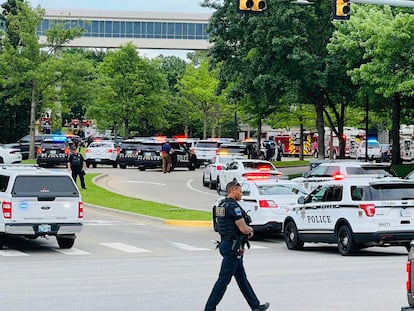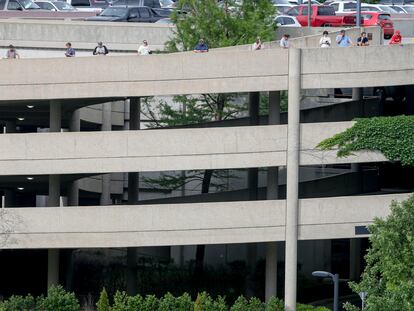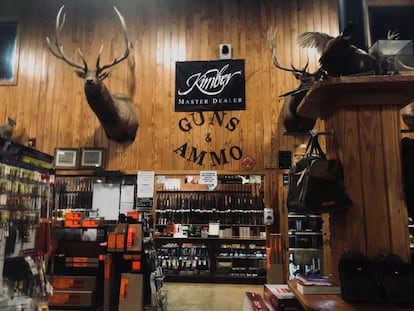Tulsa, Uvalde, Buffalo: America has 1.5 gun attacks every day on average
The latest incident, in which a man killed his doctor and three others before committing suicide, is the 233rd so far on what is setting out to be a record year for mass shootings


A man walks into a public building armed with an assault rifle, kills four people, and commits suicide. This scene took place on Wednesday afternoon at a hospital in Tulsa, Oklahoma. Similar incidents, with slightly different figures and circumstances, have taken place in Waco (Texas), Charleston (South Carolina), Benton Harbor (Michigan) and Philadelphia (Pennsylvania). And that’s this week alone.
Since the beginning of 2022 there have been 233 attacks of this nature in the US, where gun violence has become such a daily occurrence that it is coming dangerously close to dystopia. The calculations of the independent agency Gun Violence Archive, a reference source in this field, are made based on the following premises: to be considered a mass shooting, at least four people must be shot (either injured or killed), not counting the shooter. And these four people cannot be members of the same family. According to these guidelines, so far this is one of the bloodiest years in memory with 233 mass shootings — for now, the record is held by 2021 with 692. That means there have been an average of 1.5 mass shootings per day. That’s more than 10 a week, or around 45 a month.
The killing at Saint Francis Hospital in Tulsa came eight days after the one at Robb’s elementary school, in which an 18-year-old named Salvador Ramos murdered 19 children between the ages of 8 and 11 in Uvalde, Texas. and two of his teachers. Since that tragedy, there have been 20 mass shootings elsewhere in the country, proving the contagious power of violence. Some of them are especially difficult to comprehend from a European perspective, such as the weekend incident in Chattanooga (Tennessee), in which six kids ages 13 to 15 were injured in a quarrel that included two handguns. The Tulsa attack came just 18 days after the massacre in Buffalo (New York), where an 18-year-old white supremacist named Payton Gendron killed 10 African-American customers at a supermarket in Buffalo, New York.
Inability of lawmakers
In Uvalde, in Buffalo and in Tulsa, the weapon of choice was an AR-15 semi-automatic rifle, which is easily accessible to anyone over the age of 18 (who must still wait three more years to legally buy a beer). The US is once again gripped by one of its eternal debates. It is early to know if this time will be any different. But the general impression is that once again, lawmakers in Washington will be incapable of reaching an agreement to make changes to a right that is guaranteed by the Second Amendment in a country where the number of handguns (about 390 million) far exceeds the population (332 million).
The Tulsa killer’s name was Michael Louis, and he bought the rifle just a little under three hours before walking into the second floor of the Natalie Medical Building, part of the Saint Francis Hospital complex. After killing the doctor who had recently performed back surgery on him and three other people, he committed suicide with a handgun that he had bought on Monday. Unlike other mass shooters who have made recent headlines, Louis, 45, did not act randomly but was there on a specific mission to kill the doctor and anyone who got in his way, as he described in a letter that was found on his body.
At a news conference, Tulsa Police Chief Wendell Franklin, whose speedy reaction is already being hailed as a success compared with the slow response time of officers in Uvalde, echoed a feeling that is spreading throughout the country these days: that something like this can happen anywhere, any time. “We have seen the violence that has taken place throughout the United States, and we would be naïve to think that it could not happen in Tulsa,” he told reporters.
Whenever a mass shooting occurs, certain rituals are repeated all over again, and the phrase “thoughts and prayers” is pronounced by sheriffs, politicians and celebrities across the country, to the despair of those who would rather replace it with two different words: “Gun control.”
Tu suscripción se está usando en otro dispositivo
¿Quieres añadir otro usuario a tu suscripción?
Si continúas leyendo en este dispositivo, no se podrá leer en el otro.
FlechaTu suscripción se está usando en otro dispositivo y solo puedes acceder a EL PAÍS desde un dispositivo a la vez.
Si quieres compartir tu cuenta, cambia tu suscripción a la modalidad Premium, así podrás añadir otro usuario. Cada uno accederá con su propia cuenta de email, lo que os permitirá personalizar vuestra experiencia en EL PAÍS.
¿Tienes una suscripción de empresa? Accede aquí para contratar más cuentas.
En el caso de no saber quién está usando tu cuenta, te recomendamos cambiar tu contraseña aquí.
Si decides continuar compartiendo tu cuenta, este mensaje se mostrará en tu dispositivo y en el de la otra persona que está usando tu cuenta de forma indefinida, afectando a tu experiencia de lectura. Puedes consultar aquí los términos y condiciones de la suscripción digital.
More information
Archived In
Últimas noticias
Most viewed
- Sinaloa Cartel war is taking its toll on Los Chapitos
- Oona Chaplin: ‘I told James Cameron that I was living in a treehouse and starting a permaculture project with a friend’
- Reinhard Genzel, Nobel laureate in physics: ‘One-minute videos will never give you the truth’
- Why the price of coffee has skyrocketed: from Brazilian plantations to specialty coffee houses
- Silver prices are going crazy: This is what’s fueling the rally










































